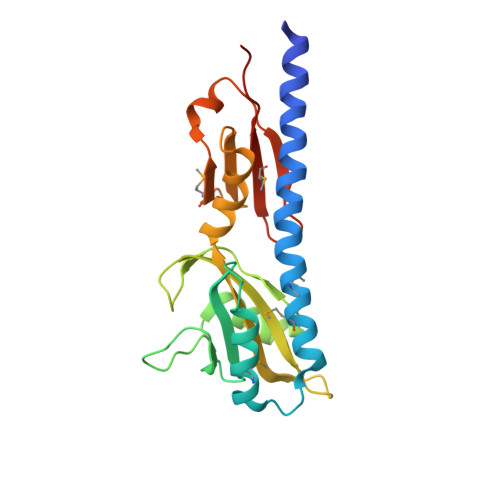Insight into the sporulation phosphorelay: Crystal structure of the sensor domain of Bacillus subtilis histidine kinase, KinD.
Wu, R., Gu, M., Wilton, R., Babnigg, G., Kim, Y., Pokkuluri, P.R., Szurmant, H., Joachimiak, A., Schiffer, M.(2013) Protein Sci 22: 564-576
- PubMed: 23436677
- DOI: https://doi.org/10.1002/pro.2237
- Primary Citation of Related Structures:
4JGO, 4JGP, 4JGQ, 4JGR - PubMed Abstract:
The Bacillus subtilis KinD signal-transducing histidine kinase is a part of the sporulation phosphorelay known to regulate important developmental decisions such as sporulation and biofilm formation. We have determined crystal structures of the extracytoplasmic sensing domain of KinD, which was copurified and crystallized with a pyruvate ligand. The structure of a ligand-binding site mutant was also determined; it was copurified and crystallized with an acetate ligand. The structure of the KinD extracytoplasmic segment is similar to that of several other sensing domains of signal transduction proteins and is composed of tandem Per-Arnt-Sim (PAS)-like domains. The KinD ligand-binding site is located on the membrane distal PAS-like domain and appears to be highly selective; a single mutation, R131A, abolishes pyruvate binding and the mutant binds acetate instead. Differential scanning fluorimetry, using a variety of monocarboxylic and dicarboxylic acids, identified pyruvate, propionate, and butyrate but not lactate, acetate, or malate as KinD ligands. A recent report found that malate induces biofilm formation in a KinD-dependent manner. It was suggested that malate might induce a metabolic shift and increased secretion of the KinD ligand of unknown identity. The structure and binding assays now suggests that this ligand is pyruvate and/or other small monocarboxylic acids. In summary, this study gives a first insight into the identity of a molecular ligand for one of the five phosphorelay kinases of B. subtilis.
Organizational Affiliation:
The Midwest Center for Structural Genomics, Biosciences, Argonne National Laboratory, Argonne, Illinois 60439, USA.
















